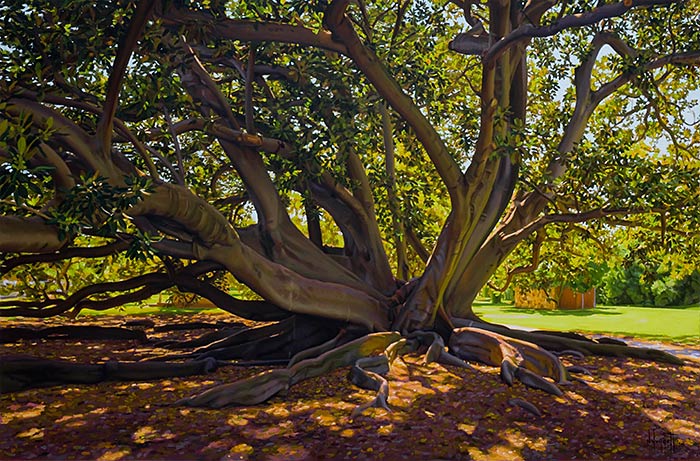
| Prev | Gallery 4: 12 Best Pieces - page 12 (of 13) |
More Details | Home Page Menu / Back to Best Pieces Overview Page

90 cm (w) x 60 cm (h), oil paints on board.
|
|
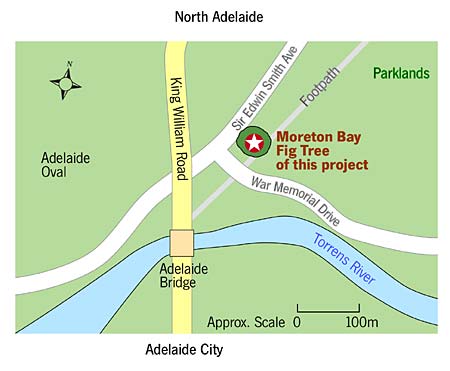
|
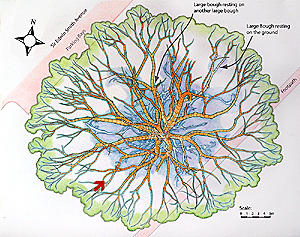
I wanted to try to produce an oil painting of the same view as that used for an on-site pastel I produced in 2006 as part of working on my Microcosm project. I wanted to produce an oil painting because I didn't want the finished image to be framed behind glass. I typically need to frame my pastels behind glass, because they are all unfixed, and are extremely fragile. 'Fixing' is done with a layer of sprayed lacquer, but this does change the refractive index of each pigment (it changes all of the colours) as well as the transparency of the pastel layers. Glass tends to include distracting reflections, and makes the darker colours more difficult to see. By producing a larger copy with oils, I hoped to create a large pastel-like image that didn't require a protective layer of glass, and that had an even wider dynamic range of observed subtle tones and colours than pastels can reproduce. The big problem was being able to get the oil painting to the subject (and home again safely) enough times to capture the subtle colours one can observe from the real subject in real light. I prefer to work entirely directly from the subject, but knew from previous attempts at producing paintings on-site, that I would not be able to get this oil painting out on-site enough (if at all). I live quite a distance from this tree, and don't have a car to transport it. Even if I did, I know that I wouldn't get enough time at the tree with the same lighting conditions to produce this painting. The light is only 'good' for about an hour each sunny day, and even this changes in the span of just a week or two (as the earth orbits around the sun each year). Other things change over the course of a couple of weeks, such as the length of the grass, the dryness of the ground, etc. I decided to try a different method of accessing the subtle observed colours in the scene. This oil painting is the result of using a combination of: 1) A pastel produced on-site directly from the scene (shown below), capturing the subtle tones and colours experienced at the scene (it was crucial that this pastel was produced during the same hour of the day over several days with the same lighting conditions), and 2) A high-quality digital photograph taken of the scene from the same observation point at 11:32 am on 9th March 2017. The photograph was taken during the first pastel session I held at the tree. The photograph was taken as a 'raw' format digital photograph, which means that it could be 'processed' using specialised software in a computer to have many of its colours and tones modified or 'tweaked'. Naturally, I used the on-site pastel here as my reference for processing the photograph that I would use as one of my guides. The photograph had the advantage of capturing a moment in time, so the unique arrangement of branches, leaves and light through the scene would be always available from this photograph. |
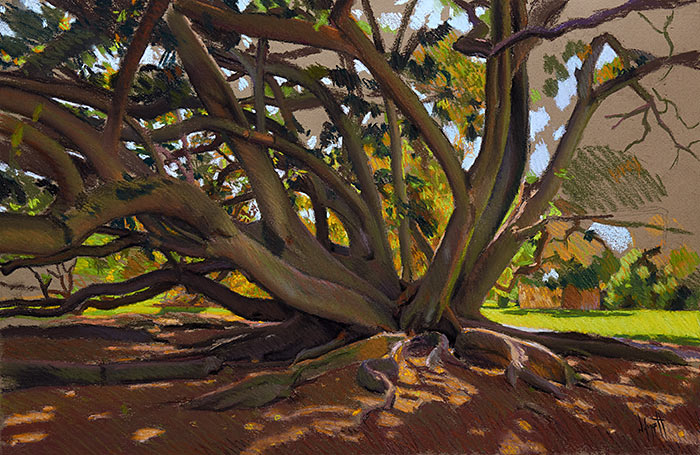
53 cm x 34.5 cm, unfixed pastels on coloured-ground paper.This pastel was produced entirely on-site, directly from the subject over about five one-hour sessions held at the same time of the day (but over 5 different days where the lighting conditions were similar). I worked quickly, directly from the subject, to record as many colours as possible, as accurately as possible. Naturally, I used this on-site pastel as my reference for processing the photograph that I would use as one of my guides. |
I realised when I first came across the tree in 1983 that it was an excellent place to be at, but now see just how special that one tree is. It is a huge tree, with branching very close to the ground. Most people can easily get amongst its massive boughs and the spaces between them. That is something very unusual in itself. But the tree also has a vast network of twisting buttress roots sitting up from the ground that makes it feel like an inviting playground. Being close to the tree means being in a changed environment; heavily darkened by the thick canopy of rubbery leaves, surrounded by many active birds with tropical calls in the canopy, amongst pleasant earthy smells of rotting figs and decaying leaves, and an atmosphere where my senses seem to be heightened (there are masses of interesting details everywhere I look). It feels special to have free access to the Adelaide Park Lands. They are an amazing resource, surrounding the City of Adelaide. I am glad and feel proud that the City of Adelaide values and protects this precious and unique resource. The actual painting looks and feels much better than the reproduction here.
This was written while sitting under the canopy of the same tree, back in 1984: At My Favourite Fig Tree And now I am at my favourite Moreton Bay Fig tree again. I love that smell, that vibrant, rich, tangy, exotic smell of life. And even though the smell is strong, it certainly does not annoy like many manufactured smells do. To get the smell properly, you have to sit here for a while and really breathe it into your nostrils. The large size of the tree structure is always refreshing. Even the cries of the birds here are exotic, clear, confident, evocative of rainforest stillness. There is a wonderful feeling of cosiness here, sitting inside, under its huge spread. To sit under the tree is like sitting in a self-enclosed, unique environment. In many ways it is just too much. Everywhere there is health, peace of mind, a tremendous sensibility, and too much of an intangible “something” here to be able to write a lot about it. The environment here is subtle and free with all the mystery of life, all the grandeur of life. There is no confusion here; not in my mind. It also seems to speak to me. It can tell me what is real, what is worth doing, what is good, what is laughable. A little fruit fly flies out into a patch of sunlight and then seems to disappear again. There is moss on the huge zig-zagging buttress roots. The ground is littered with decaying leaves, decaying fruit, twigs, bark and aroma. Some of the leaves on the ground have little pools of water trapped in them, and in these little pools would be micro worlds of minute animals, etc. Such is the richness of life! |
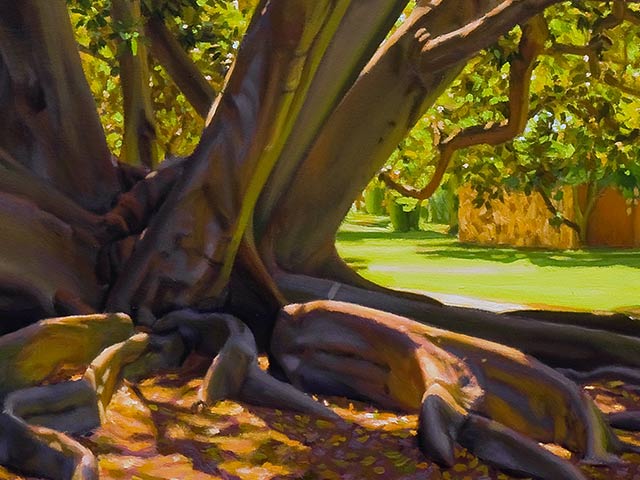
|
|

|
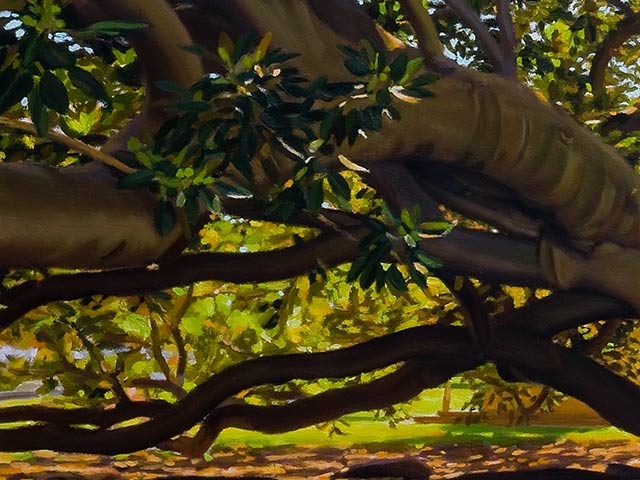
|
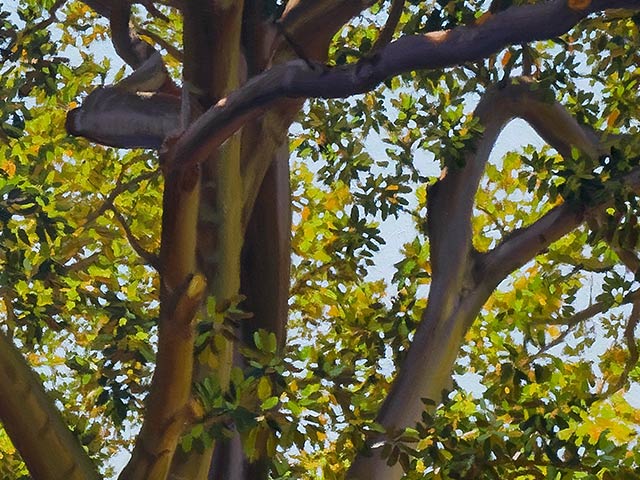
|
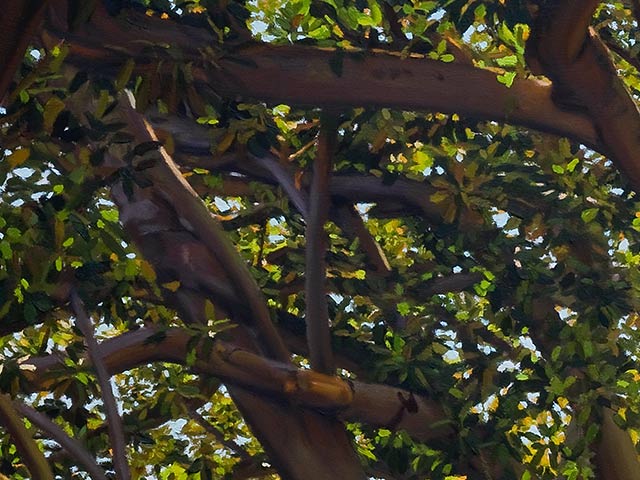
|
More Details | Home Page Menu / Back to Best Pieces Overview Page
| Prev | Gallery 4: 12 Best Pieces - page 12 (of 13) |